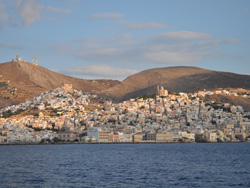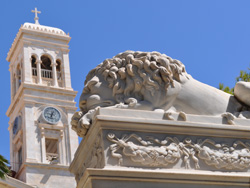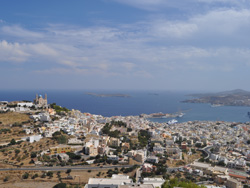| Syros
Greek National Tourism Organisation
Dionysiou Areopagitou Street 18-20
GR-11521 Athens |  | Tel. +30 210 331 0392
Fax +30 210 331 0640 |
Syros is like no other island of the Cyclades. A mix of urban settlement, seaside resorts and wilderness, with relatively few tourists, it fascinates those who take the time to explore it.
Some travelers think that you just need two days to discover Syros and that the island is not worth a longer stay. We do not agree. It keeps attracting us over the years.
No pretty Cycladic village on Syros, but a city some consider the most beautiful of Greece. No endless beaches, but some nice resorts and a multitude of secret places. And two very different atmospheres between the south and north of the island.
Mildness of the south...
Southern Syros will satisfy lovers of well equipped and easily accessible beaches, but you will also find many secluded and unspoilt beaches.
The most famous resorts, Galissas and Kini, are west of the island and are particularly lively in July and August.
... wilderness in the north...
Northern Syros, very wild, is a paradise for hikers as well as for lovers of (almost) deserted beaches.
Caution: the road ends in Kambos, 200m above sea level, and further there are only paths, don't forget to bring along water and a protection against the sun!
... and a double town in between!
Enjoy the show when arriving by ferry: Ermoupolis and Ano Syros, scattered on two hills, will impress your eyes! And it's even more beautiful at sunrise, viewed from the sea... (So feel free to leave by the first ferry in the morning!)
Ano Syros
It's the town perched on the left hill, topped by the Cathedral of Aghios Georgios (St. George). Founded by the Venetians in the 13th century AD, part of the Duchy of Naxos, it's a city where the Catholic religion was preeminent, unlike in the rest of Greece.
At the fall of the Duchy of Naxos in 1522, Syros fell to the Ottomans, but managed to retain certain privileges, including religious freedom. Moreover, an agreement between France, the Holy See and the Ottomans strengthened the protection of Catholics.
This religious freedom made of Syros a land of refuge. At the beginning of the Greek War of Independence (1821-1832), the island chose to remain neutral and welcomed many refugees from Asia Minor and Dodecanese islands.
So a new city was built: Ermoupolis, city of Hermes, messenger of the gods, guardian of roads, protector of travelers and trade.
Ermoupolis
Even if it rises up the hill on the right, topped by the Orthodox Church Anastasi, Ermoupolis is the lower town, spread around the harbor. Its heart is Miaoulis Square and the surrounding streets, paved with marble...
During the Revolutionary War arrived so many refugees that the urban organization was transformed. Catholic Greeks settled on the heights of the medieval city, while Orthodox Greek settled on the seaside, building Ermoupolis.
The city experienced a strong growth and Syros became a hub of industry, commerce and transport in the second half of the 19th century, challenging Athens.
The port
While Piraeus was still a fishing port, Ermoupolis became the largest port in Greece and out of its shipyards came thousands of boats.
Those days are long forgotten now, even if the shipyards are still part of the landscape in the southern part of the port. Nowadays, the northern part of the port is a promenade where bars and taverns spread on the quayside...
Capital of Cyclades
Not surprisingly, Ermoupolis became the administrative capital of the Cyclades. Of course, this "detail" does not interest you or us. But it is important anyway: Syros is extremely well served by ferries! |
 



|
 

|